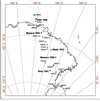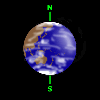 The idea of standing on the top or bottom of the Earth or being where
the compass needle points directly straight up or down has always raised
the imagination of explorers and scientists alike. The points on Earth
known as "the Poles" are not just two points, but four points, the North
and South Geographic poles and the North and South Magnetic Poles.
The idea of standing on the top or bottom of the Earth or being where
the compass needle points directly straight up or down has always raised
the imagination of explorers and scientists alike. The points on Earth
known as "the Poles" are not just two points, but four points, the North
and South Geographic poles and the North and South Magnetic Poles.
The Geographic Poles
The North and South Geographic Poles are the points on the Earth's surface
defining the axis of rotation of the Earth. They are located in the Arctic
Ocean, and within the continent of Antarctica. The axis is not perpendicular
to the plane of the Earth's orbit around the Sun; that is, the axis does
not point straight "up and down" with respect to the orbit. Instead, it
is tilted about 23.5 degrees to the perpendicular.
It is because the Earth's axis remains pointing in roughly the same direction in space that the Sun appears to move north and south over the course of a year. However, the axis is slowly changing direction over a long period of time, completing one cycle about every 26,000 years. This effect is like a spinning top slowing down, as it slows it starts to wobble, with its axis of rotation moving in a slow circle.
The Magnetic Poles
The Earth's magnetic field is tipped in relation to its geographic poles.
The field is rather complicated, and there are different possible definitions
for the Magnetic Poles. A basic magnetic field that provides the best
approximation to the Earth's field is tilted by about 11 degrees to the
Earth's rotation axis. However, the North and South Magnetic Poles that
are most often referred to are the two points on the Earth's surface where
the Earth's magnetic field points straight up and down.
The poles are presently situated at about 107°W, 80°N (in the Arctic Ocean, north of Canada), and at about 139°E, 64°S (off the coast of Antarctica). However, they do drift: the South Magnetic Pole is currently moving north west at about 5km per year, while the North Magnetic Pole is also moving north-west, but at about 20km per year.

|
Earth's magnetic field |
| Copyright owned by the State of Victoria (Department of Education and Early Childhood Development). Used with Permission. |
|
|||||||||||||||||||||||
